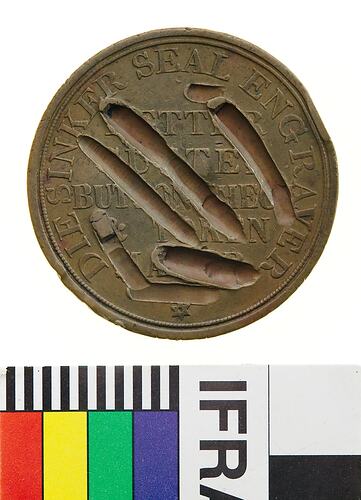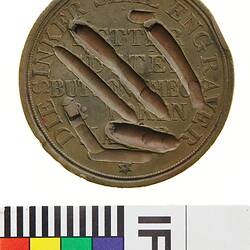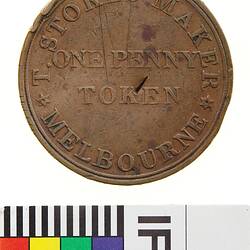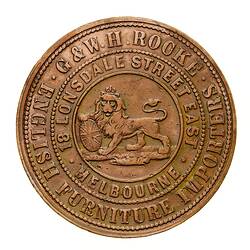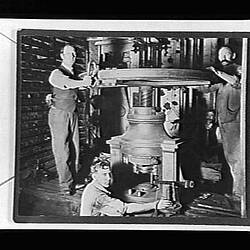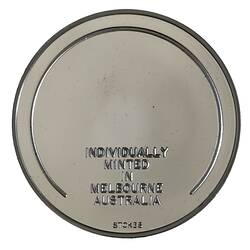Summary
Copper one Penny token, minted by Thomas Stokes of Melbourne, circa 1862. Issued by Thomas Stokes, Diesinker, Token Maker & Medallist, Melbourne. This token is one of the large number of anonymous tokens struck by Stokes late in 1862. Anonymous issues were manufactured employing two stock dies. Thomas Stokes migrated to Australia in search of gold in the 1850s, being unsuccessful he returned to his trade as a die-maker and button maker. In 1857 Stokes acquired a press from W.J. Taylor and began to mint large numbers of tradesmen's tokens. He also commenced the Australian Medallic Issues. In 1873 Stokes took a partner, Martin, and the business was re-named Stokes & Martin. In 1893 a disastrous fire damaged a large portion of the business, Martin had forgotten to renew the fire insurance policy, and the partnership was dissolved as a result. Stokes rebuilt the business as Stokes & Son. The business became a proprietary concern in 1911, re-named Stokes & Son Pty Ltd. In 1935 the business moved to Brunswick, and in 1962 Stokes became a public company, renamed Stokes (Australasia) Pty Ltd. Today the business is located in Ringwood.
Physical Description
A round copper token (34 mm diameter) giving the name, denomination and business of the issuer: T. Stokes, One Penny Token, letter cutter, button, check and token maker, die sinker, seal engraver. The reverse of the token has been deliberately defaced by a series of deep gouges.
Obverse Description
At centre in two lines, ONE PENNY / TOKEN; around above * T. STOKES MAKER; around below, MELBOURNE. Border of many small beads that look like a line where worn.
Reverse Description
Severely gouged apparently to remove the details. Legens in five lines [LE]TT[ER] / [CUT]TE[R] / BU[TTON C]HEC[K] / [& TOKE]N / [MAKER]; curved around, DIE SINKER SEAL ENGRAVER * Note the letters within the square brackets are either missing or mostly missing due to deliberate defacement.
Edge Description
Plain
More Information
-
Collection Names
-
Collecting Areas
-
Acquisition Information
Transfer from National Gallery of Victoria (NGV), Mr Alfred Chitty, 15 Mar 1976
-
Date Issued
circa 1861 AD
-
Issued By
Thomas Stokes, Melbourne, Greater Melbourne, Victoria, Australia
-
Mint
Stokes (Mint), Melbourne, Greater Melbourne, Victoria, Australia, circa 1860
Probably issued by Stokes, but may have been put into circulation through a third party. -
Previous Collection
-
Inscriptions
Obverse: T. STOKES MAKER MELBOURNE ONE PENNY TOKEN Reverse: DIE SINKER SEAL ENGRAVER LETTER CUTTER BUTTON CHECK & TOKEN MAKER (much defaced)
-
Denomination
-
Series
-
Material
Copper
-
Axis
06
-
Classification
-
Category
-
Discipline
-
Type of item
-
Dimensions
34 mm (Outside Diameter), 12.056 g (Weight)
-
Shape
Round
-
References
Stokes products which do not carry the name of an issuer but only reference to Stokes itself, are divided into four series: Series 1: has the wording T. STOKES or THOMAS STOKES MAKER MELBOURNE around the address in three lines 100 COLLINS ST. EAST plus one die where the central wording is ONE PENNY TOKEN in two lines. Series 2: has a description of the types of product, eg. BUTTON CHECK & TOKEN MAKER, around the name and address of the company, T. STOKES 100 COLLINS ST. EAST MELBOURNE. All but one die in this series has a line circle between the name and address and the products. Series 3: employs Stokes stock reverse dies for both sides of the token. In all cases one side has a Vine type, this is therefore called the obverse. Series 4: has an obverse legend in eight lines with the first, T. STOKES, and last, MELBOURNE, curved. This token belongs to Series 1. It is the only type to bear the denomination and may have been a rejected trial. It is the only example I have seen (although I did not get to the Stokes tokens in the Dixon Collection). Within this series there were three obverse dies, one dedicated reverse and a use of Stock Reverses. Obverse A T. STOKES MAKER MELBOURNE ONE PENNY TOKEN Obverse B: THOMAS STOKES MAKER 100 COLLINS ST. EAST MELBOURNE (EAST 9.8 long, border 144 beads) Obverse C: THOMAS STOKES MAKER 100 COLLINS ST. EAST MELBOURNE (EAST 11 mm long, border 135 beads) For quick visual recognition of obverses B anc C: on obverse B the T of ST. is aligned with the letters ER of MAKER while on obverse C it is aligned with the letters KE. The dedicated reverse 1 has the legend: DIE SINKER SEAL ENGRAVER LETTER CUTTER CHECK & TOKEN MAKER Obverses A and B have only been recorded with reverse 1 while obverse C has only been recorded with Stock reverses. The original die Obverse B is in the museum collection (NU 35759) and seems experimental. Unlike all other dies of the era held, it is not a tooled cylinder of about 54 mm diameter. While the working surface and its surround are normel, the base of the die has been reworked to form a narrow protrusion of 18 mm diameter. It seems clear that some experimentation was occuring in late 1861 or early 1862 and the products of obverse dies A and B should perhaps be classed as trials, though some clearly did see circulation.
[Book] Andrews, Arthur. 1921. Australasian Tokens and Coins., No. 518
[Book] Heyde, Gilbert C. & Skinner, Dion H. 1967. Unofficial Coins of Colonial Australia and New Zealand., No. 68
[Article] Sharples, John P. 1993. A Catalogue of the Trade Tokens of Victoria 1848 to 1862. Journal of the Numismatic Association of Australia. vol.7: p.1-77., V. 135
